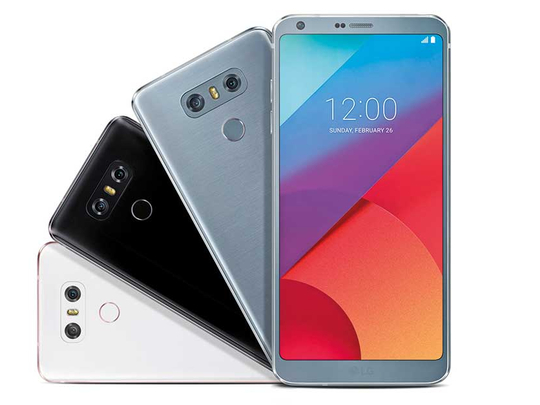
Dubai: LG has come out with its best smartphone to date - G6 – and has switched gears when compared to G5 – its first customisable modular concept.
This time, LG is pinning hopes on the good balanced phone with reduced bezels and a bigger screen without increasing the size of the phone itself.
The design formula is rather simple and straightforward with sturdy metal frame and Gorilla Glass on front and back. It weighs 162 grams.
The 5.7-inch Quad HD (2,880 x 1,440) resolution LCD display (564 pixels per inch density) is powered by quad-core 2.35GHz Qualcomm Snapdragon 821 processor with 4GB of RAM and 32GB of onboard storage. The hybrid microSD card slot supports up to 2TB.
The device runs on last year’s 14nm chip but that does not mean it is bad. The advantages of 10nm 835 chipset are not only faster but it is much more efficient CPU with support for future-proofing features such as Gigabit LTE and Quick Charge 4.0 technology.
In practice, the G6 felt plenty fast when opening apps, launching the camera, processing photo edits and so on.
The bottom edge houses the USB-C port, single speaker and mic while the right side houses SIM tray, and the left edge has the two volume keys. The top edge has the 3.5mm headphone jack.
The battery is not removable as it is IP68 dust and water resistant. The build quality is good and LG has done an outstanding job fixing the things people didn’t like about the G5.
The good thing is that the phone has an aspect ratio of 18:9 that the company is calling FullVision which allows users to view more information when surfing the web, or while reading e-books or viewing videos or play games. The industry standard is 16:9 ratio.
But the disadvantage of this new format is that the YouTube videos play in 16:9, so there are black bars on either side, and media from Amazon’s Prime app has one large bar running along the bottom.
LG should have used a software trick to extend videos to full screen.
Regular apps are fine due to Android’s native rescaling features, but games will either need to be updated or played with black bars at the bottom or in some apps, upscaling can be done .
Some of Netflix’s original series have been shot in 18:9 ratio natively.
The G6 is also the first phone to support Dolby Vision and HDR 10 formats. The fingerprint sensor, which is built into the home button, is placed at the back, just beneath the dual cameras.
Coming to cameras, the rear has two 13MP lenses. One with f/1.8 aperture and OIS while the other with f/2.4 aperture [no autofocus and no OIS] and dual-LED flash.
The rear cameras have two different fields of view: one with a standard angle less for everyday shots, and a 125-degree wide-angle lens perfect for shooting landscapes or big open spaces.
On the G6, you can switch between the standard lens and the wide-angle lens to capture more content in each frame by an icon on top of the screen. The wide-angle lens does not do well in low-light conditions.
It is better to use the regular lens in low-light conditions, which can take fantastic shots and produces a much sharper, more colourful and much cleaner image over the wide-angle lens.
It’s amazing how much you can fit into the frame when compared to the standard telephoto lens. The quality of the photos is impressive, with excellent detail, vibrant colours, great contrast and overall good dynamic range.
By turning the camera roll on in the camera settings, the new interface shows five of the most recent photos like a gallery stream on top of the screen.
The square camera app, which has four modes such as Snap, Grid, Guide and Match offer a number of different tools to take neat square photos.
In the Snap mode, half of the display shows you a preview of the image after it’s captured.
In the Grid mode, it creates four image grid of pictures or a three-second video clip, that itself is square.
The Match mode, which is like Grid mode but with two pictures instead of four, and Guide mode for matching photos using a handy transparent overlay, so people can capture the same pose or composition on multiple occasions.
It can record 2160p at 30fps and 1080p at 30/60fps. HDR support is only for images and not for videos, which is quite unusual.
The 5MP front camera with f/2.2 aperture with 100-degree wide-angle lens captures more background than the other devices.
There are also several filters to apply, and a chance to manipulate skin tone and artificial lighting sources.
Regarding connectivity, it has 4G LTE, WiFi 802.11 a, b, g, n, ac, Bluetooth 4.2, USB Type-C and NFC.
The 3,300mAh battery gave 10.35 hours of video playback or close to none hours of web browsing, which is pretty good. It gives close to one day of use for heavy users. It charges up via USB Type-C and supports Quick Charge 3 for faster charging. You can go from 0-100 per cent in about one hour and 25 minutes.
There’s no wireless charging – that’s exclusive to the US – and there’s no Quad HiFi DAC for improved sound quality. It is priced at Dh2,599.
Pros
• Beautiful design
• Water and dust resistant
• Good camera features and excellent wide-angle lens
• 18:9 screen ratio is fantastic
• Good battery life
Cons
• Old processor
• No wireless charging
• No OIS for wide-angle camera
• YouTube videos do not support new screen ratio
• Bit expensive










